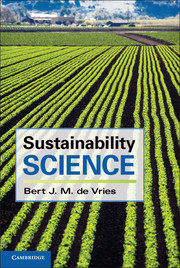Book contents
- Frontmatter
- Contents
- Preface
- 1 Introduction
- 2 The System Dynamics Perspective
- 3 In Search of Sustainability: Past Civilisations
- 4 The World in the Past 300 Years: The Great Acceleration
- 5 Sustainability: Concerns, Definitions, Indicators
- 6 Quality of Life: On Values, Knowledge and Worldviews
- 7 Energy Fundamentals
- 8 On Knowledge and Models
- 9 Land and Nature
- 10 Human Populations and Human Behaviour
- 11 Agro-Food Systems
- 12 Renewable Resources: Water, Fish and Forest
- 13 Non-Renewable Resources: The Industrial Economy
- 14 Towards a Sustainable Economy?
- 15 Outlook on Futures
- Glossary
- References
- Index
- Plate Section
- References
10 - Human Populations and Human Behaviour
Published online by Cambridge University Press: 05 January 2013
- Frontmatter
- Contents
- Preface
- 1 Introduction
- 2 The System Dynamics Perspective
- 3 In Search of Sustainability: Past Civilisations
- 4 The World in the Past 300 Years: The Great Acceleration
- 5 Sustainability: Concerns, Definitions, Indicators
- 6 Quality of Life: On Values, Knowledge and Worldviews
- 7 Energy Fundamentals
- 8 On Knowledge and Models
- 9 Land and Nature
- 10 Human Populations and Human Behaviour
- 11 Agro-Food Systems
- 12 Renewable Resources: Water, Fish and Forest
- 13 Non-Renewable Resources: The Industrial Economy
- 14 Towards a Sustainable Economy?
- 15 Outlook on Futures
- Glossary
- References
- Index
- Plate Section
- References
Summary
Introduction: The Image of Man
The previous chapter looked at ‘nature’ through the lens of geography and ecology. But almost everywhere, ‘nature’ has been influenced by ‘culture’. The word culture is rooted in the Latin word colere, which means to tend or till the land but is also related to cultus and cultivate in the sense of care, labour and worship. The relation between nature and culture is an ancient philosophical question. How deeply are you rooted in ‘nature’ and how much and what kind of freedom can be realised in ‘culture’? The narratives about past societies give provisional answers. This chapter focuses more explicitly on the species Homo sapiens in nature.
One can see nature as fundamentally subservient to human interests, as it is phrased in some biblical texts and entrenched in modernity, or as a cosmos in which humans participate as it is experienced in most pre-modern religions and modern forms of ecospirituality (Figure 8.5). Clearly, there is more than one answer to the question of how we see ourselves in nature. Are people not much more than instinct-driven animals? Are human beings the pinnacle of evolution, on the verge of a revolutionary jump in cosmic consciousness? Are we, basically, rational survival-oriented individuals with an ever larger array of tools to control our destiny? Or are we all of this? There is a huge perennial philosophy at our disposal as source of reflection and insight. Philosophers like Wilber (2001) build an integrated psychological-spiritual view in the footsteps of ancient traditions, incorporating novel scientific insights. Social scientists have developed grand theories from which some major characteristics of men as social beings emerge (§5.2; Table 6.3). Biologists and economists have their own particular image of man. The latter prefer to see men as rational beings; the former emphasise the biological roots in an evolutionary framework.
- Type
- Chapter
- Information
- Sustainability Science , pp. 296 - 338Publisher: Cambridge University PressPrint publication year: 2012



